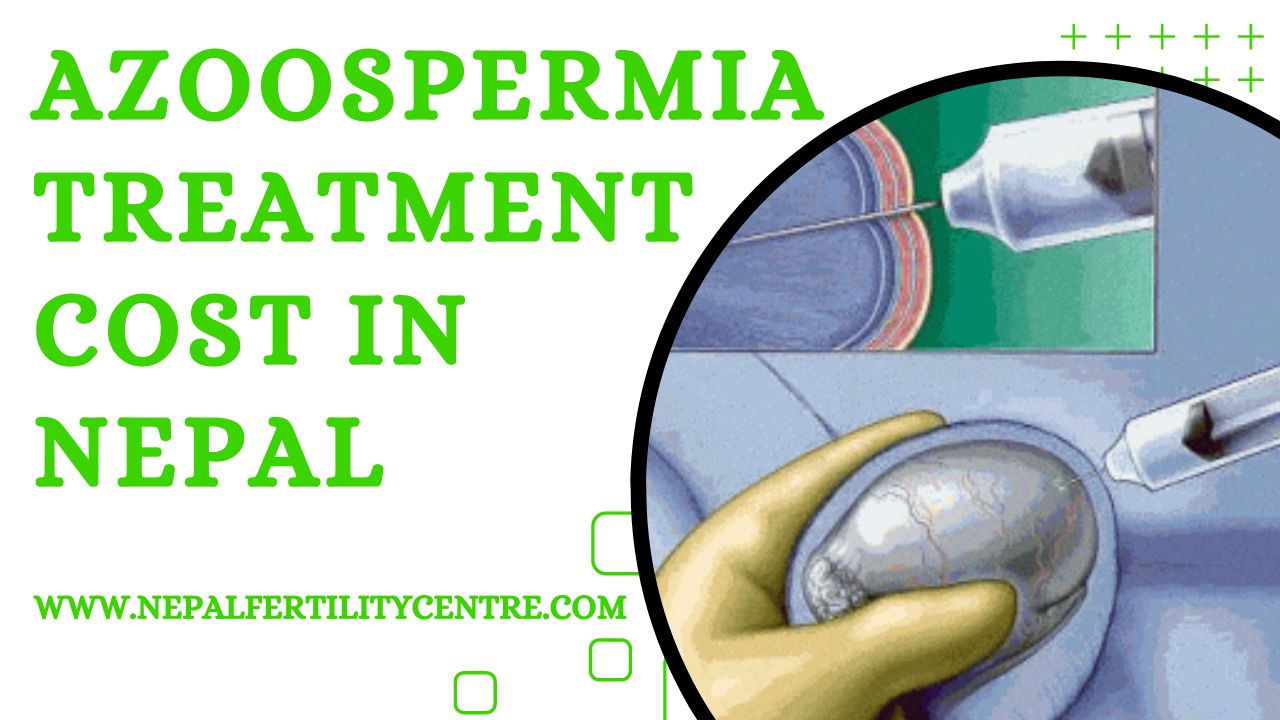Azoospermia is a condition portrayed by the shortfall of sperm in a man’s discharge, prompting male fruitlessness. In Nepal, headway in clinical science have offered desire to people and couples confronting this test, with different treatment choices accessible to address Azoospermia. Nonetheless, the expense of these therapies can be a critical thought for those looking for clinical mediation. This complete aide investigates the Azoospermia treatment cost in Nepal in 2023, providing valuable insights for prospective patients to make informed decisions about their fertility journey.
Understanding Azoospermia
Azoospermia is a condition portrayed by the shortfall of sperm in a man’s discharge. It is a huge reason for male fruitlessness and influences roughly 1% of all men and 10-15% of barren men. Figuring out the various sorts, causes, symptomatic tests, and the profound effect of Azoospermia is fundamental for people and couples confronting fertility challenges.
What is Azoospermia and its types?

Azoospermia is a condition in which the semen sample does not contain any measurable sperm. There are two main types of Azoospermia:
- Obstructive Azoospermia: In this kind, sperm creation in the testicles is typical, yet there is a blockage in the regenerative parcel, keeping sperm from arriving at the discharge. Normal causes incorporate intrinsic peculiarities, contamination, or past medical procedures that cause obstacles.
- Non-obstructive Azoospermia: This type is characterized by an inadequate production or absence of sperm in the testes. It can result from genetic factors, hormonal imbalances, or testicular dysfunction. Non-obstructive Azoospermia is often more challenging to treat than obstructive Azoospermia.
Causes and risk factors contributing to Azoospermia
Azoospermia can result from various factors, including:
- Genetic Disorders: Conditions such as Klinefelter syndrome, Y-chromosome microdeletions, or other genetic abnormalities can lead to Azoospermia.
- Varicocele: Enlarged veins in the scrotum, known as varicoceles, can interfere with sperm production.
- Hormonal Imbalances: Hormonal imbalances, particularly low levels of testosterone or high levels of prolactin, can affect sperm production.
- Infections: Infections such as mumps orchitis or sexually transmitted infections can cause damage to the testes, leading to Azoospermia.
- Testicular Injury or Surgery: Trauma to the testes or previous surgeries in the reproductive tract can result in Azoospermia.
- Chemotherapy or Radiation: Cancer treatments like chemotherapy or radiation can damage the testes and affect sperm production.
Diagnostic tests for Azoospermia and its classification
Diagnosing Azoospermia requires a comprehensive evaluation by a fertility specialist. Diagnostic tests include:
- Semen Analysis: A semen analysis is the first step in diagnosing Azoospermia. It involves examining a semen sample under a microscope to determine the absence of sperm.
- Hormonal Tests: Blood tests are conducted to assess hormone levels, including testosterone, follicle-stimulating hormone (FSH), and luteinizing hormone (LH).
- Genetic Testing: Genetic testing may be performed to identify any genetic factors contributing to Azoospermia.
- Testicular Biopsy: In cases of non-obstructive Azoospermia, a testicular biopsy may be conducted to retrieve testicular tissue for further examination.
Azoospermia is classified based on the findings of these tests, determining whether it is obstructive or non-obstructive.
Psychological and emotional impact of Azoospermia on individuals and couples
Azoospermia diagnosis can have a profound emotional impact on both individuals and couples. For men diagnosed with Azoospermia, feelings of shock, guilt, and inadequacy are common. The inability to father a child naturally can lead to a sense of loss and grief.
For couples, the diagnosis can be devastating, and feelings of frustration, sadness, and hopelessness may arise. The uncertainty surrounding the chance of parenthood can strain the relationship, and couples may experience communication challenges.
Seeking emotional support and counseling can help individuals and couples cope with the psychological impact of Azoospermia diagnosis and the fertility journey ahead.
Treatment options for Azoospermia and their success rates
The treatment approach for Azoospermia depends on the type and underlying cause. Treatment options may include:
- Obstructive Azoospermia: Surgical procedures, such as vasectomy reversal or sperm retrieval from the epididymis or testes, are viable options. The success rates for these procedures can be high, especially if there is an adequate number of sperm present.
- Non-obstructive Azoospermia: Treatment options may include hormonal therapy, testicular sperm extraction (TESE), or sperm retrieval combined with assisted reproductive techniques like In-Vitro Fertilization (IVF) with Intracytoplasmic Sperm Injection (ICSI). The success rates for non-obstructive Azoospermia treatment vary depending on factors such as the severity of the condition and the patient’s age.
Overall,Understanding Azoospermia is essential for individuals and couples facing fertility challenges. A condition requires a complete assessment and customized treatment approach. The close to home effect of Azoospermia on people and couples ought to be considered carefully, and looking for everyday reassurance is pivotal all through the richness venture. With progressions in clinical science, there is potential for those determined to have Azoospermia, and the right treatment options can help individuals fulfill their dreams of parenthood.

Factors Affecting Azoospermia Treatment Cost
The cost of Azoospermia treatment in Nepal can vary significantly due to several factors. Understanding these variables is critical for imminent patients to plan and financial plan for their fertility process. Here are the key factors that impact the expense of Azoospermia treatment:
- Type of Azoospermia: The type of Azoospermia, obstructive or non-obstructive, assumes a huge part in deciding the treatment approach and cost. Obstructive Azoospermia is brought about by a blockage in the regenerative plot, and surgeries to address the blockage might be more direct and practical. Then again, non-obstructive Azoospermia, which is because of an issue with sperm creation, may require more mind boggling medicines, such as Testicular Sperm Aspiration (TESA) or Testicular Sperm Extraction (TESE), which can impact the overall treatment cost.
- Treatment Protocol: The recommended treatment protocol for Azoospermia can vary based on individual cases and the underlying cause of infertility. A few patients might answer well to clinical administration with hormonal treatments, while others might require more obtrusive systems like careful sperm recovery or helped conceptive strategies like In-Vitro Preparation (IVF) with Intracytoplasmic Sperm Infusion (ICSI). The complexity and extent of the chosen treatment protocol can significantly influence the overall cost.
- Clinic Reputation and Location: The reputation and location of the fertility clinic can also impact the cost of Azoospermia treatment. Clinics with a high success rate and advanced technology may have higher treatment costs. Additionally, clinics located in metropolitan areas or major cities may have higher fees compared to those in smaller towns.
- Specialist’s Expertise: The experience and skill of the fertility specialist handling the Azoospermia case can affect the treatment cost. Highly experienced specialists may charge higher fees for their services. However, it is essential to remember that the expertise of the specialist is instrumental in achieving successful outcomes.
- Diagnostic Tests: A comprehensive evaluation to diagnose the underlying cause of Azoospermia may involve various diagnostic tests. These tests help determine the most appropriate treatment plan and identify any other associated conditions that need addressing. The cost of diagnostic tests can vary depending on their complexity and the number of tests required.
- Medications: The cost of medications prescribed during the Azoospermia treatment can contribute significantly to the overall expenses. The type of medications used and their duration of use can vary depending on the chosen treatment protocol.
- Additional Procedures: In some cases, extra systems or medicines might be important to address explicit fertility concerns. For example, assuming hereditary irregularities are identified, Pre-implantation Hereditary Testing (PGT) might be suggested, which incurs additional costs.
It is crucial for individuals and couples to discuss these factors with their fertility expert during the underlying conference. An unmistakable comprehension of the treatment choices, their related expenses, and the probability of progress will enable patients to go with very much educated choices in regards to their Azoospermia treatment.
Prospective patients shouldn’t exclusively zero in on cost contemplations yet in addition focus on the nature of care, achievement paces of the center, and the help given by the clinical group. Putting resources into a respectable and experienced ripeness center can improve the possibilities of fruitful results and at last carry desire to those looking to conquer Azoospermia and achieve their dream of parenthood.

Cost Breakdown of Azoospermia Treatment in Nepal
Azoospermia, a condition where no sperm is present in the ejaculate, requires a thorough evaluation and personalized treatment approach. The cost of Azoospermia treatment in Nepal can vary based on several factors, including the type of Azoospermia, treatment protocol, clinic reputation, specialist’s expertise, diagnostic tests, medications, and any additional procedures required. Let’s delve into the cost breakdown of various Azoospermia treatment options available in Nepal:
- Initial Consultation and Diagnostic Tests: The journey begins with an initial consultation with a fertility specialist who will conduct a detailed medical history review and recommend comprehensive diagnostic tests. The diagnostic workup typically includes semen analysis, hormone assessments, genetic testing, scrotal ultrasound, and other specialized tests to determine the underlying cause of Azoospermia. The cost for this stage can range from NPR 15,000 to 30,000.
- Medical Management: For some cases of Azoospermia with hormonal imbalances or reversible causes, medical management may be the first-line treatment. Hormonal therapies, such as Human Chorionic Gonadotropin (hCG), Gonadotropin-releasing hormone (GnRH), or Clomiphene Citrate, can stimulate sperm production. The cost of hormonal medications can range from NPR 5,000 to 15,000 per cycle.
- Surgical Interventions: In cases of obstructive Azoospermia, where there is a blockage in the reproductive tract preventing the sperm from reaching the ejaculate, surgical interventions are required. Procedures like Testicular Sperm Aspiration (TESA) or Testicular Sperm Extraction (TESE) are performed to directly retrieve sperm from the testes. The cost for surgical procedures may vary from NPR 40,000 to 100,000, depending on the complexity of the case and the expertise of the surgeon.
- Assisted Reproductive Techniques (ART): For non-obstructive Azoospermia or cases where surgical interventions are unsuccessful, Assisted Reproductive Techniques (ART) like In-Vitro Fertilization (IVF) with Intracytoplasmic Sperm Injection (ICSI) offer a chance for biological parenthood. IVF with ICSI involves fertilizing the retrieved sperm with the partner’s or donor eggs in a laboratory setting before transferring the resulting embryos into the uterus. The cost for IVF with ICSI in Nepal can range from NPR 300,000 to 600,000 or more, depending on the clinic, medications, and number of treatment cycles required.
- Post-Treatment Medications and Follow-up: After the completion of any Azoospermia treatment, patients may require post-treatment medications to support the body during the reproductive process. Follow-up consultations with the fertility specialist are essential to monitor progress and make any necessary adjustments. The cost for post-treatment medications and follow-up consultations can vary based on individual needs, ranging from NPR 10,000 to 20,000.
- Additional Procedures and Treatments: Some cases of Azoospermia may require additional procedures, such as sperm retrieval from the epididymis (Microscopic Epididymal Sperm Aspiration – MESA) or using testicular tissues for sperm extraction (Testicular Sperm Aspiration – TESA). These procedures can add to the overall treatment cost and may range from NPR 50,000 to 100,000 or more.
It’s important to note that the cost of Azoospermia treatment can be affected by different variables, for example, the area of the facility, the achievement paces of the fertility place, and the consideration of cutting edge research center strategies like sperm freezing or Pre-Implantation Hereditary Testing (PGT). Also, the quantity of treatment cycles required may affect the general expense for patients.
In Additions, The cost of Azoospermia treatment in Nepal can vary based on individual factors and the treatment approach chosen. Notwithstanding, with headways in clinical science and a scope of treatment choices accessible, people confronting Azoospermia get an opportunity to beat male barrenness and seek after their fantasies of life as a parent. Imminent patients are urged to talk with experienced fertility subject matter experts, completely examine treatment choices, and explore available financial assistance to embark on their fertility journey with hope and confidence.

Can Azoospermia be diagnosed? If Yes, How?
It’s a big question to ask, Can Azoospermia be diagnosed?
Yes! There are profuse methods to diagnose Azoospermia. With the help of various conditions and states, you can check for Azoospermia.
Before the diagnosis in laboratories, you can check it through the medical history-
- Fertility failures in past
- Injuries or surgeries in the pelvic area
- Urinary infections
- History of STD
- Exposure to radiations or psychotherapy
- Consumption of drugs or alcohol
- Genetic infertility issues
- Through medical examination of the body-
- Lack of maturation of reproductive organs
- Less probability of men’s ejaculation
- Blockage in the testicles or ejaculatory duct
- Through tests and quizzes-
- Checkup of testosterone and FSH (Follicle-stimulating hormones)
- X-ray or ultrasound of reproductive organs to check any physical damage
- Brain CT scans to identify hypothalamus gland issues
- Genetic testing
- Biopsy (also known as tissues sampling), where samples of tissues are checked to locate any problems.
- Azoospermia can be diagnosed in laboratories using a high-powered microscope and Centrifuge.
What are the causes of Azoospermia?

These are beaucoup reasons that can cause Azoospermia that includes-
Causes of Obstructive Azoospermia-
- Injury or surgery in vas deferens, epididymis, or ejaculatory ducts
- Infections and inflammation in the pelvic area
- Vasectomy- A planned procedure where vas deferens are clamped to prevent movement of sperms- It is a thoroughly planned procedure
- Cystic fibrosis gene mutation blocks the flow of semen
Causes of Non-Obstructive Azoospermia-
- Genetic infertility disorder
- Hormonal changes or imbalance
- Ejaculation issues due to the blockage in testicles or ejaculatory duct.
- Illness like kidney failure, diabetes, tumor, and cancer
- Absence of testicles (Anorchia)
- Testicular torsion
Insurance Coverage and Financial Assistance
- Insurance Coverage for Azoospermia Treatment: In Nepal, the extent of insurance coverage for Azoospermia treatment may vary depending on the insurance plan and its terms. Some insurance providers offer coverage for medically necessary treatments, including diagnostic tests and certain treatment procedures. However, coverage for fertility treatments like IVF with ICSI or surgical interventions may vary, and elective procedures may not be covered.
- Financial Assistance and Payment Plans: People looking for Azoospermia treatment in Nepal might investigate monetary help choices presented by fertility centers, clinics, or altruistic associations. A few facilities might furnish installment designs or team up with monetary help projects to assist patients with overseeing treatment costs. Also, there are magnanimous establishments that deal awards or backing to people encountering fertility challenges. Imminent patients are urged to ask about accessible monetary guide and installment choices during their interviews to find the most reasonable help for their Azoospermia treatment journey.
Can Azoospermia be prevented?
‘Prevention is better than cure’
And that is one of the reasons why many people have one question in mind other than the cost of Azoospermia in Nepal, and that is – Can Azoospermia be prevented?
Well, in shedload cases, it can be prevented, by for issues like Vasectomy, there are other solutions.
Try to avoid injury in reproductive organs
Try avoiding radiations and chemo
You should be aware of medications that could cause infertility issues and be bad for reproductive health.
What is the treatment procedure for Azoospermia?

The treatment technique for Azoospermia relies upon the basic reason for the condition and whether it is obstructive or non-obstructive Azoospermia. Azoospermia is analyzed when there is a shortfall of sperm in the discharge. The treatment choices include:
Medical Management
On the off chance that Azoospermia is brought about by a hormonal unevenness or blockage, clinical administration might be suggested. Hormonal treatments, for example, gonadotropin-delivering chemical (GnRH) or human chorionic gonadotropin (hCG), can invigorate sperm creation or resolve blockages. However, this approach is effective only for some cases of Azoospermia.
Surgical Interventions
Surgical procedures may be necessary for obstructive Azoospermia, where the sperm production is normal, but there is a blockage preventing sperm from reaching the ejaculate. Common surgical interventions include:
- Vasectomy Reversal: On the off chance that a past vasectomy caused the blockage, a vasectomy inversion can be performed to reconnect the vas deferens.
- Epididymal Sperm Aspiration (PESA): In PESA, sperm is suctioned from the epididymis, a looped tube that conveys sperm from the testicles. The recovered sperm can then be utilized for Intra-Cytoplasmic Sperm Infusion (ICSI) during IVF.
- Testicular Sperm Aspiration (TESA) or Testicular Sperm Extraction (TESE): In TESA or TESE, sperm is directly retrieved from the testicles using a fine needle or biopsy, respectively.
Assisted Reproductive Techniques (ART)
For cases of non-obstructive Azoospermia or when surgical interventions are not feasible, helped regenerative methods can be utilized to accomplish pregnancy. The most well-known Workmanship utilized is In-Vitro Preparation (IVF) with Intracytoplasmic Sperm Infusion (ICSI). In ICSI, a solitary sperm is straightforwardly infused into the recovered egg to accomplish preparation. The resulting embryo is then transferred into the woman’s uterus.
Donor Sperm
In some cases where sperm production is severely impaired or not possible, using donor sperm may be an option. Donor sperm can be obtained from sperm banks or through known donors.
Adoption or Surrogacy
In the event that the male accomplice’s sperm isn’t reasonable for ripeness medicines, couples might consider reception or surrogacy as elective choices to construct a family.
It is essential to talk with a fruitfulness expert to decide the most suitable therapy approach in light of individual clinical history and richness factors. The picked treatment will rely upon the particular reason for Azoospermia and the couple’s richness objectives. Open correspondence with the medical care supplier will help in understanding the choices accessible and pursuing informed choices for the most ideal result.
What is the Cost of Azoospermia in Nepal?
The cost of Azoospermia treatment in Nepal can vary depending on several factors, including the type of Azoospermia (obstructive or non-obstructive), the specific treatment protocol recommended by the fertility specialist, the clinic’s reputation and location, and the expertise of the medical team.
Generally, Azoospermia treatment may involve initial consultation and diagnostic tests, medical management with hormonal therapies, surgical interventions like Testicular Sperm Aspiration (TESA) or Testicular Sperm Extraction (TESE), and assisted reproductive techniques such as In-Vitro Fertilization (IVF) with Intracytoplasmic Sperm Injection (ICSI).
In Nepal, the cost of Azoospermia treatment can range from NPR 100,000 to 500,000 or more, depending on the factors mentioned above. The total cost may also vary based on the number of treatment cycles required and any additional procedures or medications needed.
It is fundamental for people looking for Azoospermia therapy to talk with a fruitfulness subject matter expert or a respectable fertility clinic in Nepal to get a customized quote in light of their particular ailment and treatment necessities. Furthermore, patients can ask about any suitable monetary help or installment designs that might assist with dealing with the treatment costs.

Conclusion
Azoospermia treatment in Nepal in 2023 gives desire to those encountering male barrenness, however understanding the expense is essential for imminent patients. This exhaustive aide digs into the elements affecting treatment expenses and offers bits of knowledge to assist people with settling on informed conclusions about their fertility journey. By talking with experienced richness trained professionals and investigating monetary help choices, planned patients can conquer the monetary difficulties and access proper Azoospermia treatment, making ready for the chance of building a family and satisfying their life as a parent dreams.
FAQ
1. What is Azoospermia, and can it be treated in Nepal?
Azoospermia is a condition characterized by the absence of sperm in the ejaculate. Yes, Azoospermia can be treated in Nepal through various medical interventions, depending on the type of Azoospermia (obstructive or non-obstructive) and individual factors.
2. What are the treatment options available for Azoospermia in Nepal?
Azoospermia treatment options in Nepal may include medical management, surgical procedures such as Testicular Sperm Aspiration (TESA) or Testicular Sperm Extraction (TESE), and assisted reproductive techniques like In-Vitro Fertilization (IVF) with Intracytoplasmic Sperm Injection (ICSI).
3. What factors influence the cost of Azoospermia treatment in Nepal?
The cost of Azoospermia treatment in Nepal can vary based on factors like the type of Azoospermia, the specific treatment protocol recommended, the reputation and location of the fertility clinic, and the expertise of the medical team.
4. Are there any success rates for Azoospermia treatment in Nepal?
Success rates for Azoospermia treatment may vary depending on individual factors and the type of treatment chosen. It is advisable to consult with a fertility specialist to understand the potential success rates based on individual circumstances.
5. Does insurance cover Azoospermia treatment in Nepal?
The extent of insurance coverage for Azoospermia treatment in Nepal may vary depending on the insurance plan and its terms. Some insurance providers offer partial or full coverage for medically necessary treatments.
6. Are there financial assistance options available for Azoospermia treatment in Nepal?
Some fertility clinics or organizations may offer financial assistance programs or payment plans to support patients undergoing Azoospermia treatment. Prospective patients can inquire about these options during consultations.
Read Also:

